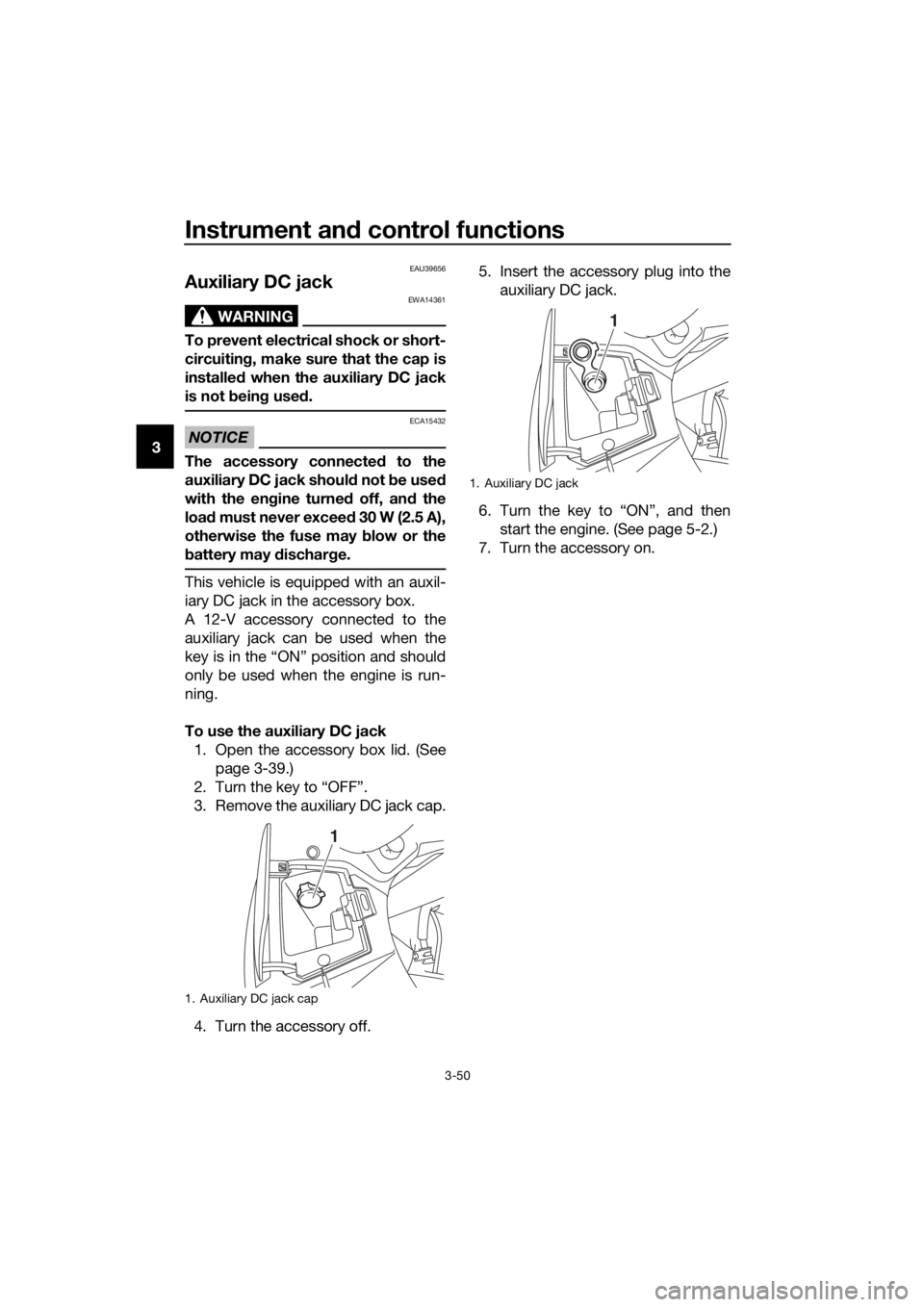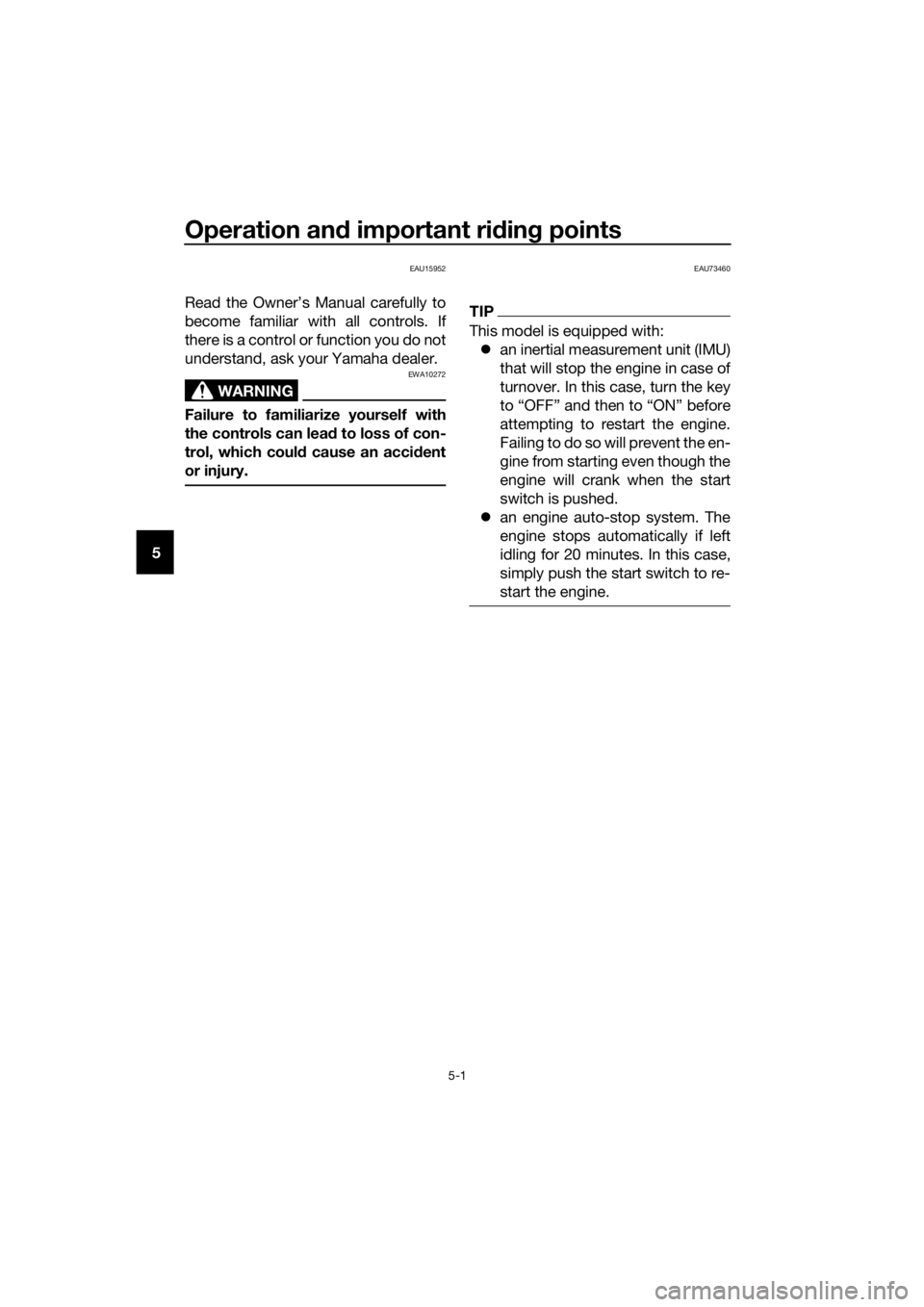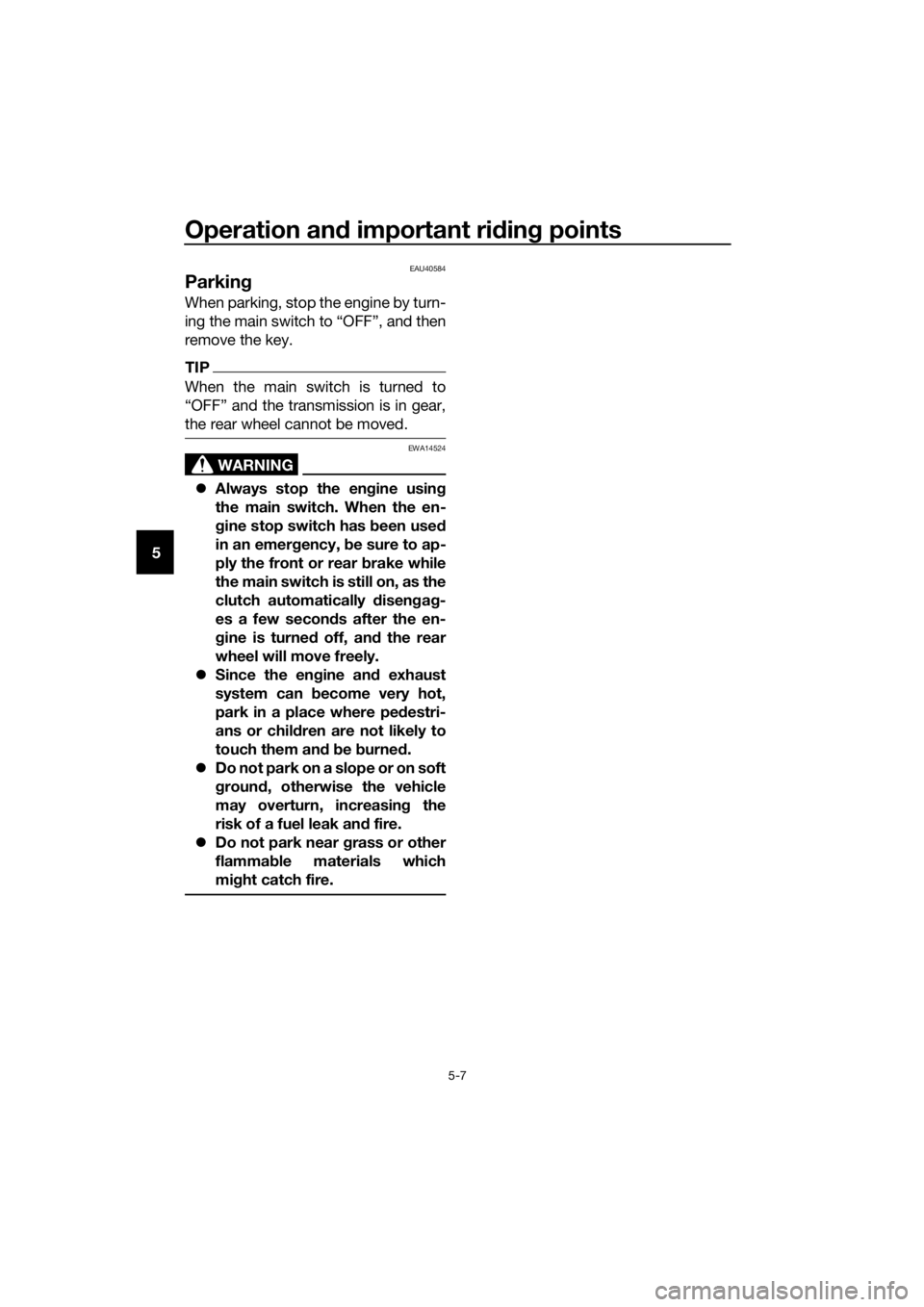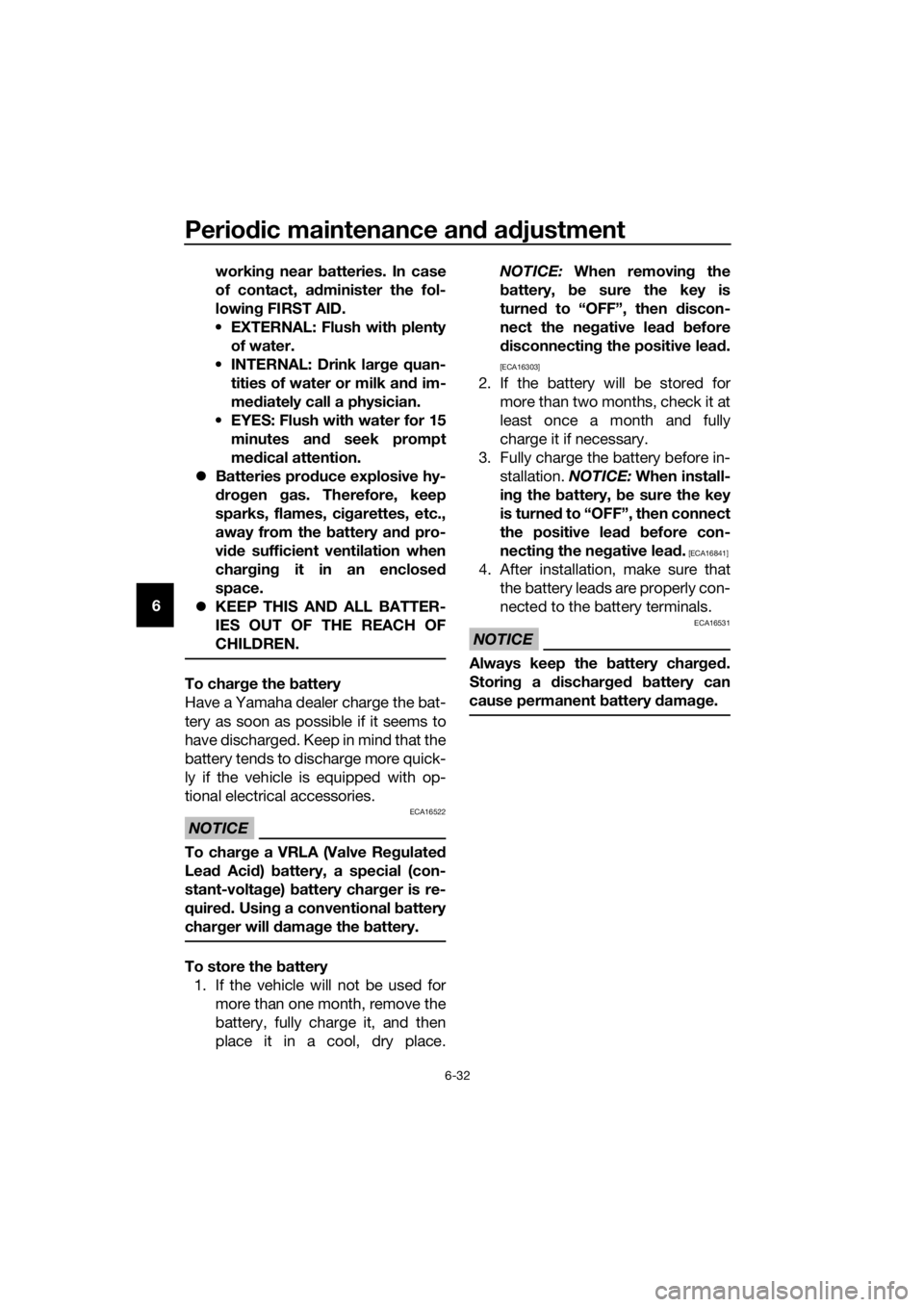2016 YAMAHA FJR1300AS key
[x] Cancel search: keyPage 64 of 126

Instrument and control functions
3-50
3
EAU39656
Auxiliary DC jack
WARNING
EWA14361
To prevent electrical shock or short-
circuitin g, make sure that the cap is
installe d when the auxiliary DC jack
is not b eing use d.
NOTICE
ECA15432
The accessory connecte d to the
auxiliary DC jack shoul d not b e used
with the en gine turne d off, an d the
loa d must never exceed 30 W (2.5 A),
otherwise the fuse may blow or the
b attery may d ischarge.
This vehicle is equipped with an auxil-
iary DC jack in the accessory box.
A 12-V accessory connected to the
auxiliary jack can be used when the
key is in the “ON” position and should
only be used when the engine is run-
ning.
To use the auxiliary DC jack
1. Open the accessory box lid. (See page 3-39.)
2. Turn the key to “OFF”.
3. Remove the auxiliary DC jack cap.
4. Turn the accessory off. 5. Insert the accessory plug into the
auxiliary DC jack.
6. Turn the key to “ON”, and then start the engine. (See page 5-2.)
7. Turn the accessory on.
1. Auxiliary DC jack cap
1
1. Auxiliary DC jack
1
UB95E0E0.book Page 50 Friday, February 19, 2016 2:15 PM
Page 68 of 126

Operation and important rid ing points
5-1
5
EAU15952
Read the Owner’s Manual carefully to
become familiar with all controls. If
there is a control or function you do not
understand, ask your Yamaha dealer.
WARNING
EWA10272
Failure to familiarize yourself with
the controls can lead to loss of con-
trol, which coul d cause an acci dent
or injury.
EAU73460
TIP
This model is equipped with: an inertial measurement unit (IMU)
that will stop the engine in case of
turnover. In this case, turn the key
to “OFF” and then to “ON” before
attempting to restart the engine.
Failing to do so will prevent the en-
gine from starting even though the
engine will crank when the start
switch is pushed.
an engine auto-stop system. The
engine stops automatically if left
idling for 20 minutes. In this case,
simply push the start switch to re-
start the engine.
UB95E0E0.book Page 1 Friday, February 19, 2016 2:15 PM
Page 69 of 126

Operation and important ri din g points
5-2
5
EAU55472
Startin g the eng ine
WARNING
EWA16411
Always apply the front or rear brake
while the main switch is in the “ON”
position an d the transmission is in
g ear. Otherwise, the vehicle may
su ddenly start to move when the en-
g ine is starte d, causin g loss of con-
trol an d possi bly an acci dent.
In order for the ignition circuit cut-off
system to enable starting, one of the
following conditions must be met:
The front or rear brake is applied
with the transmission in the neu-
tral position whether the sidestand
is up or down.
The front or rear brake is applied
with the transmission in gear and
the sidestand is up.
See page 3-48 for more informa-
tion.
1. Turn the key to “ON” and make sure that the start/engine stop
switch is set to “ ”.
The following warning lights and
indicator lights should come on for
a few seconds, then go off. Oil level warning light
Engine trouble warning light
Traction control system indi-
cator/warning light
Cruise control indicator lights
Electronically adjustable sus-
pension system warning light
Shift down indicator light
YCC-S system warning light
Stop mode function indicator
light
Immobilizer system indicator
light
TIP
If the stop mode function was activat-
ed when the key was turned to “OFF”
then the stop mode function is still ac-
tivated and the indicator light will re-
main on.
NOTICE
ECA11834
If a warnin g or in dicator li ght does
not come on initially when the key is
turne d to “ON”, or if a warnin g or in-
d icator li ght remains on, see pag e
3-4 for the correspon din g warnin g
an d in dicator li ght circuit check.
The ABS warning light should
come on when the key is turned to
“ON”, and then go off after travel-
ing at a speed of 10 km/h (6 mi/h)
or higher.
NOTICE
ECA17682
If the ABS warnin g li ght does not
come on an d then go off as ex-
plained above, see pa ge 3-4 for the
warnin g li ght circuit check.
2. Shift the transmission into the
neutral position. The neutral indi-
cator light should come on. If not,
ask a Yamaha dealer to check the
electrical circuit.
3. Start the engine by pushing the “ ” side of the start/engine
stop switch with the front or rear
brake applied.
If the engine fails to start, release
the start/engine stop switch, wait
a few seconds, and then try again.
Each starting attempt should be
as short as possible to preserve
UB95E0E0.book Page 2 Friday, February 19, 2016 2:15 PM
Page 74 of 126

Operation and important rid ing points
5-7
5
EAU40584
Parkin g
When parking, stop the engine by turn-
ing the main switch to “OFF”, and then
remove the key.
TIP
When the main switch is turned to
“OFF” and the transmission is in gear,
the rear wheel cannot be moved.
WARNING
EWA14524
Always stop the en gine usin g
the main switch. When the en-
g ine stop switch has b een used
in an emer gency, be sure to ap-
ply the front or rear brake while
the main switch is still on, as the
clutch automatically d isengag -
es a few secon ds after the en-
g ine is turne d off, an d the rear
wheel will move freely.
Since the en gine an d exhaust
system can become very hot,
park in a place where pe destri-
ans or chil dren are not likely to
touch them an d b e burne d.
Do not park on a slope or on soft
groun d, otherwise the vehicle
may overturn, increasin g the
risk of a fuel leak an d fire.
Do not park near grass or other
flamma ble materials which
mi ght catch fire.
UB95E0E0.book Page 7 Friday, February 19, 2016 2:15 PM
Page 106 of 126

Periodic maintenance an d a djustment
6-32
6 workin
g near b atteries. In case
of contact, ad minister the fol-
lowin g FIRST AID.
EXTERNAL: Flush with plenty of water.
INTERNAL: Drink lar ge quan-
tities of water or milk an d im-
me diately call a physician.
EYES: Flush with water for 15 minutes and seek prompt
me dical attention.
Batteries pro duce explosive hy-
d ro gen gas. Therefore, keep
sparks, flames, ci garettes, etc.,
away from the battery an d pro-
vi de sufficient ventilation when
char gin g it in an enclosed
space.
KEEP THIS AND ALL BATTER-
IES OUT OF THE REACH OF
CHILDREN.
To char ge the battery
Have a Yamaha dealer charge the bat-
tery as soon as possible if it seems to
have discharged. Keep in mind that the
battery tends to discharge more quick-
ly if the vehicle is equipped with op-
tional electrical accessories.
NOTICE
ECA16522
To char ge a VRLA (Valve Re gulate d
Lea d Aci d) battery, a special (con-
stant-volta ge) battery char ger is re-
quired . Using a conventional battery
char ger will dama ge the b attery.
To store the battery
1. If the vehicle will not be used for more than one month, remove the
battery, fully charge it, and then
place it in a cool, dry place. NOTICE:
When removin g the
b attery, be sure the key is
turne d to “OFF”, then d iscon-
nect the neg ative lead b efore
d isconnectin g the positive lea d.
[ECA16303]
2. If the battery will be stored for
more than two months, check it at
least once a month and fully
charge it if necessary.
3. Fully charge the battery before in- stallation. NOTICE: When install-
in g the b attery, be sure the key
is turne d to “OFF”, then connect
the positive lea d before con-
nectin g the ne gative lea d.
[ECA16841]
4. After installation, make sure that
the battery leads are properly con-
nected to the battery terminals.
NOTICE
ECA16531
Always keep the b attery charged .
Storin g a d ischar ged battery can
cause permanent b attery damag e.
UB95E0E0.book Page 32 Friday, February 19, 2016 2:15 PM
Page 107 of 126

Periodic maintenance an d a djustment
6-33
6
EAU54515
Replacin g the fuses
The fuse boxes and individual fuses
are located under panel A. (See page
6-7.)
If a fuse is blown, replace it as follows.1. Turn the key to “OFF” and turn off the electrical circuit in question.
2. Remove the blown fuse, and then install a new fuse of the specified
amperage. WARNING! Do not
use a fuse of a hi gher ampera ge
ratin g than recommen ded to
avoi d causin g extensive dam-
a g e to the electrical system an d
possi bly a fire.
[EWA15132]
1. Main fuse
2. Spare fuse
3. Cruise control fuse
4. Brake light fuse
5. Fuse box
6. Main fuse 2
5
1
3
4
2
5 26
1. ABS motor fuse
2. ABS solenoid fuse
3. Fuel injection system fuse
4. Backup fuse (for clock and immobilizer sys-
tem)
5. Electronic throttle valve fuse
6. Headlight fuse
7. Spare fuse
8. YCC-S motor control fuse
9. Suspension fuse
10.Signaling system fuse
11.Terminal fuse 1 (for auxiliary DC jack)
12.ABS control unit fuse
13.Ignition fuse
14.Right radiator fan motor fuse
15.Left radiator fan motor fuse
16.Hazard fuse
17.Windshield motor fuse
15 7
11
10121314
71716
8
1
9
234
5
67
7
UB95E0E0.book Page 33 Friday, February 19, 2016 2:15 PM
Page 108 of 126

Periodic maintenance an d a djustment
6-34
6
3. Turn the key to “ON” and turn onthe electrical circuit in question to
check if the device operates.
4. If the fuse immediately blows again, have a Yamaha dealer
check the electrical system.
EAU72980
Vehicle li ghts
This model is equipped with full-LED
lighting. There are no user replaceable
bulbs.
If a light does not come on, check the
fuses and then have a Yamaha dealer
check the vehicle.
NOTICE
ECA16581
Do not affix any type of tinted film or
stickers to the head light lens.
Specifie d fuses:
Main fuse: 50.0 A
Main fuse 2:
30.0 A
Te r m i n a l f u s e 1 : 3.0 A
Headlight fuse: 7.5 A
Brake light fuse:
1.0 A
Signaling system fuse: 7.5 A
Ignition fuse: 20.0 A
Radiator fan motor fuse:
10.0 A × 2
Backup fuse: 7.5 A
Hazard fuse: 7.5 A
Fuel injection system fuse:
15.0 A
ABS control unit fuse: 7.5 A
ABS motor fuse: 30.0 A
ABS solenoid fuse:
20.0 A
Suspension fuse: 15.0 A
YCC-S motor control fuse: 30.0 A
Cruise control fuse:
1.0 A
Windshield motor fuse: 20.0 A
Electronic throttle valve fuse: 7.5 A
UB95E0E0.book Page 34 Friday, February 19, 2016 2:15 PM